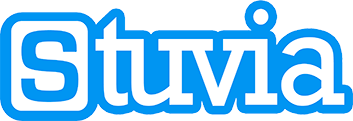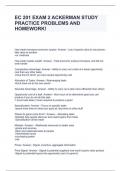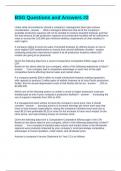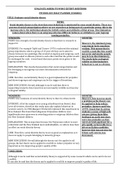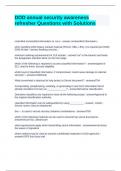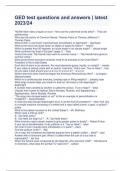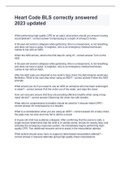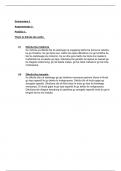✅ ORDER NOW ✅ 🎓 TO GET INSTANT EXPERT HELP 🎓 ✅
ORDER NOW ✅
NIHSS (NIH) Stroke Scale Training and Certification Reference
(APEX/AHA NIHSS) Exam Study Guide | 100% Pass Guaranteed |
Graded A+ |
2025- 2026
NIHSS (NIH) Stroke Scale (APEX / AHA NIHSS) Exams
NIH Stroke Scale (NIHSS) Certification and Training
Read All Instructions Carefully and Answer All the Questions
Correctly Good Luck: -
,N I H ST R O KE SC AL E ( N I H SS)
1a. Level of Consciousness (LOC)
0 = Alert, keenly responsive
1 = Not alert; but arousable by minor stimulation
2 = Not alert; requires repeated stimulation, or is obtunded and needs strong/painful stimuli to make movements
3 = Responds only with reflex motor or autonomic effects or totally unresponsive, flaccid, and areflexic
Examiner must choose a response if full evaluation is prevented by such obstacles as ET tube, language barrier, oral
trauma/bandages etc. A3 is only scored only if the patient makes no movement (other than reflexive posturing) in
response to noxious stimuli.
1b. LOC Questions – “What month is it?” and “How old are you?”
0 = Answers both questions correctly
1 = Answers one question correctly
2 = Answers neither question correctly
Score only initial answer (no credit for being close). Patients unable to speak due to intubation, oral trauma, severe
dysarthria, language barrier, etc. are scored 1. Aphasic and stuporous patients, score 2.
1c. LOC Commands – “Open and close your eyes”, and “Grip and release your hand”
0 = Performs both tasks correctly
1 = Performs one task correctly
2 = Performs neither task correctly
Substitute another one-step command if hands cannot be used. Credit given if attempt made but
unable to complete due to weakness. If patient does not respond to command, task should be
demonstrated and result scored. Only first attempt scored.
3 v.20140811
,NI HS S ( c o n t i nued )
2. Best Gaze (only horizontal movement tested)
Establish contact and ask patient “follow my finger”
0 = Normal
1 = Partial gaze palsy
2 = Forced deviation or total gaze paresis
Appropriate for aphasic patients. Forced deviation or total gaze paresis is not overcome by oculocephalic maneuver.
Score voluntary or reflexive, horizontal movements (not caloric test). Test patients with ocular trauma, bandages,
blindness, etc., for reflexive movement. Patients with conjugate deviation of the eyes (overcome by voluntary or
reflexive activity) and those with peripheral nerve paresis (oculomotor valve CN III, IV, VI) are scored 1.
3. Visual Fields – Use confrontation, finger counting, or visual threat. Confront upper/lower
quadrants of visual field
0 = No visual loss
1 = Partial hemianopia
2 = Complete hemianopia
3 = Bilateral hemianopia
Test patients with unilateral blindness or enucleation in remaining eye. Patients with clear-cut
asymmetry, including quadrantanopia, are scored 1. Blind patients are scored 3. Test again using
double simultaneous stimulation. Score 1 for extinction and record under item #13.
4 v.20140811
,NI HS S ( c o n t i nued )
4. Facial Palsy
By words or pantomime, encourage the patient to “Show me your teeth.” “Raise your eyebrows.” “Close your eyes.”
0 = Normal symmetrical movements
1 = Minor paralysis (flattened nasolabial fold, asymmetry on smile)
2 = Partial paralysis (lower face)
3 = Complete paralysis
Remove bandages, tape, tubes before testing if possible. In poorly responsive patients, some symmetry of grimace to
noxious stimuli.
5 & 6. Motor Arm (Right and Left)
Alternately position patient’s arm. Extend each arm with palms down (90 degrees if sitting, 45 if supine).
0 = No drift 3 = No effort against gravity
1 = Drift 4 = No movement
2 = Some effort vs. gravity UN = Amputation or joint fusion
Test each arm in turn (nonparetic first). Drift is scored if arm falls before 10 seconds.
7 & 8. Motor Leg (Right and Left)
Alternately position patient’s leg. Extend each leg (30 degrees while supine).
0 = No drift 3 = No effort against gravity
1 = Drift 4 = No movement
2 = Some effort vs. gravity UN = Amputation or joint fusion
Test each leg in turn (nonparetic first). Drift is scored if leg falls before 5 seconds.
5 v.20140811
, NI HS S ( c o n t i nued )
9. Limb Ataxia
Ask patient (eyes open) to “Touch your finger to your nose.” “Touch your heel to your shin.”
0 = Absent 2 = Present in two limbs
1 = Present in one limb UN = Amputation or joint fusion
Preform finger-nose and heel-shin test on both sides to determine unilateral cerebellar lesion. Score 0 if paralyzed or
cannot understand. Score 1 or 2 only if ataxia disproportionate to weakness. Only UN if amputated or contracted.
10. Sensory
Test as many body parts as possible (arms [not hands], legs, trunk, face) for sensation using pinprick or noxious
stimulus
(if obtunded or aphasic).
0 = Normal
1 = Mid to moderate sensory loss
2 = Severe to total sensory loss
Score sensory loss due to stroke only. Stuporous or aphasic, score 0 or 1.
11. Best Language
Using included pictures and sentence list, ask the patient to “Describe what you see in this picture.” “Name
the items in the picture.” “ Read these sentences.”
0 = No aphasia 2 = Severe aphasia
1 = Mild to Moderate aphasia 3 = Mute, global aphasia
Patients with visual loss can be asked to identify and describe objects placed in the hand. Intubated
patients should be asked to write their answers. The examiner must choose a score for stuporous
or uncooperative patients. Only comatose patients & mute patients unable to follow one step
commands are scored 3.
6 v.20140811
